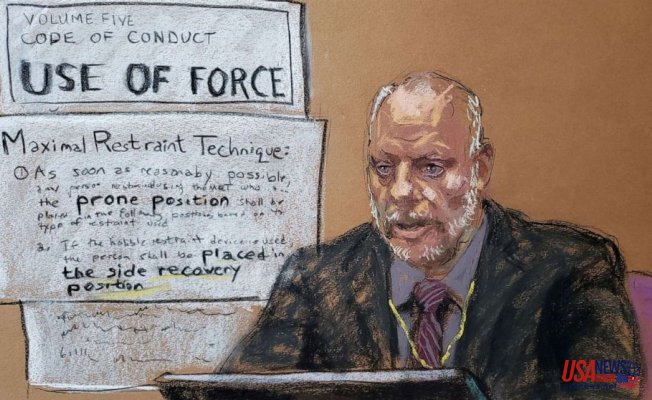Some have said the former officer's actions didn't follow department policy.
Law enforcement colleagues of former Minneapolis police officer Derek Chauvin largely have coped with the actions he chose to restrain George Floyd.
Here Is What they have said up to now:
Chauvin's manager: Knees can be used as a restraint just until a topic is handcuffed and under control
Sgt. David Pleoger, now retired, was Chauvin's supervisor since 2008 and has been working as his manager on the night of May 25, the afternoon Floyd died.
Pleoger was first notified of this episode from 911 dispatcher Jena Scurry, who testified on Day 1 of this trial that she called him after understanding that something was wrong whilst seeing the episode unfold on a police camera that was fixed.
After Pleoger talked to Scurry, he predicted Chauvin on his mobile phone.
"We only had to hold the guy down. He was going mad... would not go in the back of the squad."
Chauvin subsequently turned his body off, which Pleoger testified is allowed by department policy at that point since it was a private conversation.
When Pleoger arrived on the scene, he is seen in his own body camera footage telling Chauvin to gather the witnesses, to that Chauvin replied that could attempt but the witnesses were"hostile."
Pleoger testified he, Chauvin and former officer Tou Thao, the officer on the scene who monitored the bystanders, went to the hospital.
It wasn't until the former officers were advised that Floyd had expired that Pleoger began asking Chauvin more inquiries and discovered that he had controlled Floyd by kneeling on his throat. Chauvin didn't say how long he maintained Floyd in that place, Pleoger said.
Pleoger explained that section policy did allow officers to utilize a knee to restrain a subject but just until that subject is handcuffed and under control.
"When Mr. Floyd was no longer offering any resistance up from the officers, they could have finished the restraint," Pleoger explained.
Department homicide unit principal: Subjects Will Need to get off their chest'as soon as possible'
After Minnesota Assistant Attorney General Matthew Frank asked Zimmerman whether he had been trained to kneel on the throat of someone who's handcuffed, Zimmerman responded,"No. If your knee reaches a person's neck, that may kill them."
Zimmerman added,"When a person has been cuffed, the threat level goes down all the way. They are cuffed. How do they actually hurt you?"
Frank also requested Zimmerman what Minnesota Police officers are trained to do when they have somebody at the vulnerable position, when they're lying on their stomachs.
"Once you handcuff a person, you want to get them from the prone position whenever possible since it restricts their breathing," Zimmerman responded. "You need them off their chest."
Zimmerman was among a group of 14 Minneapolis Police officers that signed an open letter into the neighborhood in June condemning Chauvin's actions.
Authorities Chief Medaria Arradondo: Chauvin's actions'certainly not a part of our ethics and values'
Minneapolis Police Chief Medaria Arradondo testified that it was close to midnight on May 25 when one of his deputy chiefs alerted him Floyd had died.
Prosecutor Steve Schleicher pressed Arradondo on if Chauvin's activities followed division policies. Arradondo responded that applying"that amount of drive" administered to a individual in the vulnerable position and handcuffed behind their back is"in no way, shape or form" part of department policy.
"It isn't part of our practice, and it's certainly not a part of our integrity or values," Arradondo explained.
Inspector Katie Blackwell: Chauvin utilized an'improvised position' on Floyd
Minneapolis Police Department Inspector Katie Blackwell, who had been responsible for training at the time of Floyd's death, testified that she's known Chauvin for 20 decades and even picked him to become a field training officer at one point.
When Schleicher revealed Blackwell a still from a movie shooting by witness Darnella Frazier where Chauvin is seen kneeling on Floyd's throat, he asked if it was a training technique taught by the department when she was overseeing this unit.
"It isn't," Blackwell responded.
"I really don't understand what kind of improvised position that's," she explained. "It is not what we train"
Department crisis intervention coordinator:'Immediate goal' of officers ought to be seeking medical care for persons in crisis
Minneapolis Police Department Sgt. Ker Yang, a 24-year veteran of the department who now serves as its crisis intervention training planner, said that Chauvin participated in a 40-hour crisis intervention course in 2016 where officers have been given opportunities to recognize a person who may be in crisis and how to deal with them.
The department's crucial decision-making model comprises software for use of crisis and force training, Yang said.
Yang explained that a"crisis" could be a scenario"that is beyond a individual's coping mechanism, and past that, what's beyond their control."
"Sometimes they don't know what to do," Yang said. "And we train them to help a individual to bring them back down to their own pre-crisis level."
Yang stated that it's essential for officers to reassess whether circumstances change throughout a situation, adding that in the event the individual in crisis is in need of medical attention, it ought to"be the immediate target" for officers to help provide it.
During training, it is common"to slow things down and re-eval and reassess" moving through the model, Yang said.
"I provide this training because I believe it will -- it functions," Yang said.
When a defense attorney emphasized that a catastrophe includes people other than the defendant, including bystanders who might also present a hazard, Yang agreed that the risk to this officer is higher as the intensity of the crisis develops.
Yang also said this might indicate that there are multiple crises happening simultaneously, as well as the fact that a catastrophe that could"look bad" to some bystander might still be a legal necessity.
Use-of-force instructor: A knee to the neck is not a trained restraint
Mercil testified that when trying to control a topic, officers are trained to use the concept of"proportionality," which is to"use the smallest degree of force possible to meet these goals" in order to maintain all parties secure.
As the degree of resistance rises, the degree of pressure can subsequently increase, Mercil explained.
Physicians are trained to de-escalate scenarios as the level of immunity decreases and are trained to understand that some parts of the body are more prone to injury, like the neck and the head, Mercil said.
Minneapolis Police Department policy comprises two types of neck restraints, that are performed by"slowing the blood flow to and from the mind, with the aim to get control of the subject," Mercil explained.
The mindful neck restraint entails wrapping up somebody but leaving the topic conscious, Mercil said, adding that this process often works to gain compliance. The unconscious neck restraint involves applying pressure before whoever isn't complying becomes unconscious and"therefore compliant," Mercil explained.
When prosecutors revealed Mercil an image of Chauvin together with his knee Floyd's neck, Mercil said that the procedure shown is not and hasn't been an authorized restraint technique taught by the Minneapolis Police Department.
Mercil added that while the procedure Chauvin used is not technically an unauthorized use of force under the department's policy, he considers the technique would not be approved because Floyd was under control and handcuffed.
When questioned by the defense, Mercil explained that while section training does instruct the usage of body weight to control a subject, they also"tell officers to stay away from the neck when possible, also when you are likely to use body weight to pin, to put it in their shoulder and be mindful of position."
When shown images of different angles of Floyd's arrest, Mercil stated that the image did not appear to show a neck restraint but rather a likely hold an officer may apply with his or her knee. Mercil also agreed that the still images at the same point seem to reveal Chauvin's shin to be across Floyd's shoulder blade.
Mercil afterwards said that he did not believe it would be good to hold a subject in that likely restraint position for an extended period, especially after the topic stopped resisting or didn't have a heartbeat.
He's now on medical leave.













